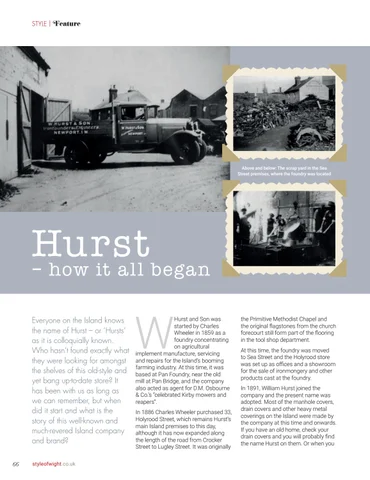STYLE | Feature
Above and below: The scrap yard in the Sea Street premises, where the foundry was located
Hurst – how it a ll began Everyone on the Island knows the name of Hurst – or ‘Hursts’ as it is colloquially known. Who hasn’t found exactly what they were looking for amongst the shelves of this old-style and yet bang up-to-date store? It has been with us as long as we can remember, but when did it start and what is the story of this well-known and much-revered Island company and brand? 66
styleofwight.co.uk
W
Hurst and Son was started by Charles Wheeler in 1859 as a foundry concentrating on agricultural implement manufacture, servicing and repairs for the Island’s booming farming industry. At this time, it was based at Pan Foundry, near the old mill at Pan Bridge, and the company also acted as agent for D.M. Osbourne & Co.’s “celebrated Kirby mowers and reapers”. In 1886 Charles Wheeler purchased 33, Holyrood Street, which remains Hurst’s main Island premises to this day, although it has now expanded along the length of the road from Crocker Street to Lugley Street. It was originally
the Primitive Methodist Chapel and the original flagstones from the church forecourt still form part of the flooring in the tool shop department. At this time, the foundry was moved to Sea Street and the Holyrood store was set up as offices and a showroom for the sale of ironmongery and other products cast at the foundry. In 1891, William Hurst joined the company and the present name was adopted. Most of the manhole covers, drain covers and other heavy metal coverings on the Island were made by the company at this time and onwards. If you have an old home, check your drain covers and you will probably find the name Hurst on them. Or when you

































